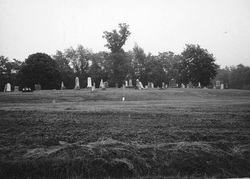History of Wimmer Cemetery and its Interred

Back in 1999 a very determined lady named Mary Ann Decatoire decided she had seen enough destruction of the cemetery over the years and it was about time to clean up that little lot down at the end of her road. Just before the Fourth of July weekend that year, Mary Ann wrote to the Auburn Citizen asking for help to clean up the weeds that weekend so the soldiers buried there would have a respectful remembrance during the celebration of our nation's birthday. A small group of people gathered that day and mowed, raked, pulled weeds, and cleaned stones. This was the beginning of the group that would form into the Wimmer Cemetery Association.
Upon removing the basic problems at the cemetery, it was decided that more information needed to be collected as to how many actual burial sites existed at the cemetery. We began digging with probes and found that several stones had become buried over the years by falling down or being pushed over by vandals. A search of historical records was also conducted using the Auburn Citizen archives as well as several historical records in the Sangamon Valley Collection of Springfield's Lincoln Library. Thus it was found that the earliest known death and burial for Wimmer Cemetery was that of Mrs. Elizabeth Walker who died in the fall of 1819, and was buried in what was then called the "Wimmer burying ground." An incident occurred at the time of this death that exhibits one of the dangers that beset the early settlers. While the friends were gathered around the dying bed, it was discovered that a prairie fire was rapidly approaching, propelled by a strong westerly wind. The grass, seven or eight feet in height, was as dry as powder. By the most vigorous exertions in keeping the end of the cabin near the fire, wet, the house was saved, but all the hay stocked for winter feeding, was destroyed. In the midst of the excitement the sick woman breathed her last.[1] There was no marker found for Elizabeth as well as several other burials that are known to have occurred in this cemetery, however, a plaque was posted on the back side of the entrance sign to honor those who were buried in Wimmer whose markers have vanished over the years.
The Vancil family spent their first winter in the wagons they arrived in until they could gather wood to make cabins that following year. This must have been a big hardship as the prairie provided little shelter from the strong winter winds that blew across the landscape during Illinois' blustery winter. Along with the Vancil family came the Pattons, Dills, Shutts, Orrs, Kesslers and Wimmer families who made up the earliest settlers of our township. Each family claimed their part of the township and began building their homesteads becoming a community after a short period. These are the people whose bodies are interred in this cemetery. Each person has a story to be told and it is with great pleasure that we share these stories of their struggles and accomplishments.
[1] History of Sangamon County, Illinois, Chicago: Interstate Publishing Company, 1881, page 749
Upon removing the basic problems at the cemetery, it was decided that more information needed to be collected as to how many actual burial sites existed at the cemetery. We began digging with probes and found that several stones had become buried over the years by falling down or being pushed over by vandals. A search of historical records was also conducted using the Auburn Citizen archives as well as several historical records in the Sangamon Valley Collection of Springfield's Lincoln Library. Thus it was found that the earliest known death and burial for Wimmer Cemetery was that of Mrs. Elizabeth Walker who died in the fall of 1819, and was buried in what was then called the "Wimmer burying ground." An incident occurred at the time of this death that exhibits one of the dangers that beset the early settlers. While the friends were gathered around the dying bed, it was discovered that a prairie fire was rapidly approaching, propelled by a strong westerly wind. The grass, seven or eight feet in height, was as dry as powder. By the most vigorous exertions in keeping the end of the cabin near the fire, wet, the house was saved, but all the hay stocked for winter feeding, was destroyed. In the midst of the excitement the sick woman breathed her last.[1] There was no marker found for Elizabeth as well as several other burials that are known to have occurred in this cemetery, however, a plaque was posted on the back side of the entrance sign to honor those who were buried in Wimmer whose markers have vanished over the years.
The Vancil family spent their first winter in the wagons they arrived in until they could gather wood to make cabins that following year. This must have been a big hardship as the prairie provided little shelter from the strong winter winds that blew across the landscape during Illinois' blustery winter. Along with the Vancil family came the Pattons, Dills, Shutts, Orrs, Kesslers and Wimmer families who made up the earliest settlers of our township. Each family claimed their part of the township and began building their homesteads becoming a community after a short period. These are the people whose bodies are interred in this cemetery. Each person has a story to be told and it is with great pleasure that we share these stories of their struggles and accomplishments.
[1] History of Sangamon County, Illinois, Chicago: Interstate Publishing Company, 1881, page 749